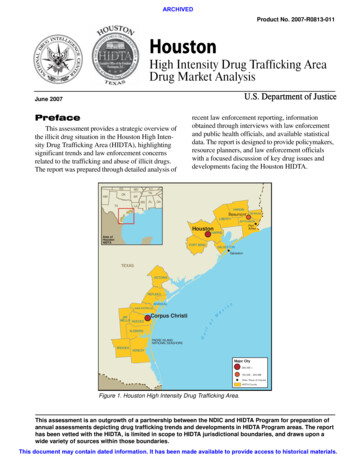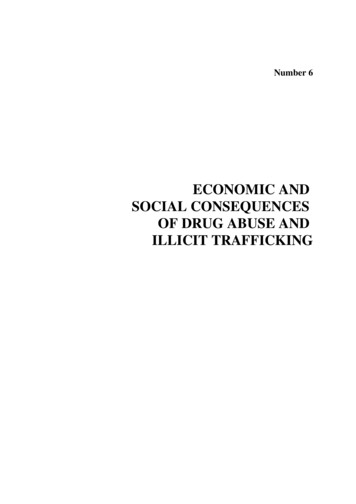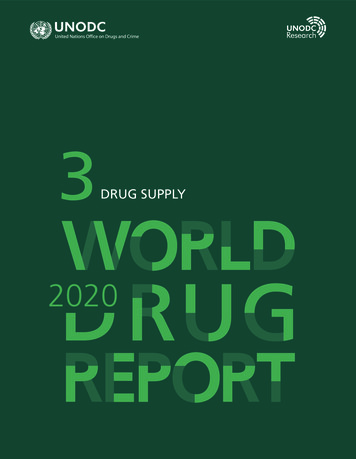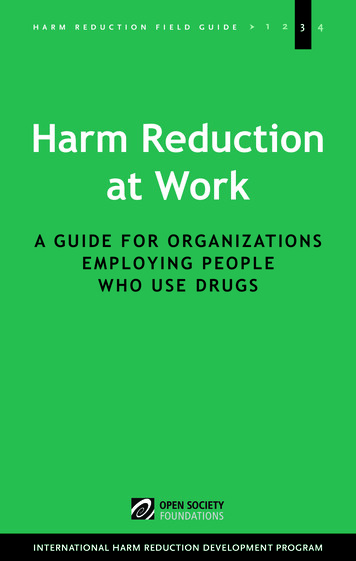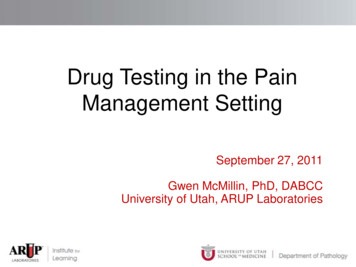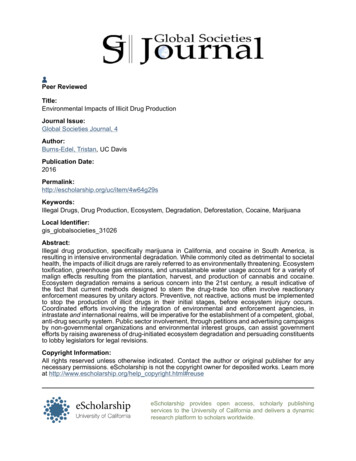
Transcription
Peer ReviewedTitle:Environmental Impacts of Illicit Drug ProductionJournal Issue:Global Societies Journal, 4Author:Burns-Edel, Tristan, UC DavisPublication /4w64g29sKeywords:Illegal Drugs, Drug Production, Ecosystem, Degradation, Deforestation, Cocaine, MarijuanaLocal Identifier:gis globalsocieties 31026Abstract:Illegal drug production, specifically marijuana in California, and cocaine in South America, isresulting in intensive environmental degradation. While commonly cited as detrimental to societalhealth, the impacts of illicit drugs are rarely referred to as environmentally threatening. Ecosystemtoxification, greenhouse gas emissions, and unsustainable water usage account for a variety ofmalign effects resulting from the plantation, harvest, and production of cannabis and cocaine.Ecosystem degradation remains a serious concern into the 21st century, a result indicative ofthe fact that current methods designed to stem the drug-trade too often involve reactionaryenforcement measures by unitary actors. Preventive, not reactive, actions must be implementedto stop the production of illicit drugs in their initial stages, before ecosystem injury occurs.Coordinated efforts involving the integration of environmental and enforcement agencies, inintrastate and international realms, will be imperative for the establishment of a competent, global,anti-drug security system. Public sector involvement, through petitions and advertising campaignsby non-governmental organizations and environmental interest groups, can assist governmentefforts by raising awareness of drug-initiated ecosystem degradation and persuading constituentsto lobby legislators for legal revisions.Copyright Information:All rights reserved unless otherwise indicated. Contact the author or original publisher for anynecessary permissions. eScholarship is not the copyright owner for deposited works. Learn moreat http://www.escholarship.org/help copyright.html#reuseeScholarship provides open access, scholarly publishingservices to the University of California and delivers a dynamicresearch platform to scholars worldwide.
1 Global Societies Journal, Volume 4, 2016Environmental Impacts ofIllicit Drug ProductionTristan Burns-Edel, UC DavisABSTRACTIllegal drug production, specifically marijuana in California, and cocaine in SouthAmerica, is resulting in intensive environmental degradation. While commonlycited as detrimental to societal health, the impacts of illicit drugs are rarelyreferred to as environmentally threatening. Ecosystem toxification, greenhousegas emissions, and unsustainable water usage account for a variety of maligneffects resulting from the plantation, harvest, and production of cannabis andcocaine. Ecosystem degradation remains a serious concern into the 21st century, aresult indicative of the fact that current methods designed to stem the drug-tradetoo often involve reactionary enforcement measures by unitary actors. Preventive,not reactive, actions must be implemented to stop the production of illicit drugs intheir initial stages, before ecosystem injury occurs. Coordinated efforts involvingthe integration of environmental and enforcement agencies, in intrastate andinternational realms, will be imperative for the establishment of a competent,global, anti-drug security system. Public sector involvement, through petitionsand advertising campaigns by non-governmental organizations and environmentalinterest groups, can assist government efforts by raising awareness of druginitiated ecosystem degradation and persuading constituents to lobby legislatorsfor legal revisions.Keywords: Illegal Drugs; Drug Production; Ecosystem; Degradation; Deforestation;Cocaine; MarijuanaINTRODUCTIONThe consumption of cocaine and marijuana has long been a concern of modernsociety. Starting with Richard Nixon’s declaration of a “War on Drugs” in 1971, theUnited States has been fixated on the correlation between illicit drugs and crime rates,incarceration, and societal health. The impacts of illicit drugs however, have rarely beenaddressed in their relation to the environment. Revelations of the severe damagesincurred on the environment as a consequence of cannabis and cocaine production will benecessary for the revision of bureaucratic frameworks and societal perspectives. Once thepublic has been properly informed of the issues at hand, they subsequently will be able to
Environmental Impacts of Illicit Drugs 2appeal to their legislators for legal reform. Government agencies, both environmental andenforcement, must also contribute to anti-drug efforts by taking on the responsibility ofincorporating their knowledge and resources with their counterparts, both domestic andinternational, in order to adequately address this global issue.ENVIRONMENTAL ISSUESToxificationToxification of the environment, resulting from the plantation, growth, andharvest of cocaine and cannabis occurs in a variety of methods. Toxification, classified inthis paper, refers to the improper or illegal usage and disposal of fertilizers, pesticides,rodenticides, and chemical compounds employed during the production of cannabis andcocaine. Unregulated usage of illegal fertilizers and pesticides in illicit crop growthresults in the direct poisoning of wildlife and the indirect toxification of watersheds. Onecalendar year in Colombia saw “81,000 tons of fertilizers, pesticides and herbicides” usedin the cultivation of coca crops.1Toxification of watersheds, occurring either due to the disposal of cocaine, or ofthe chemical compounds used in its formation, raises a serious concern for the health ofaquatic ecosystems and species biodiversity. A major waterway purity study conducted inBrazil revealed that cocaine occurred in higher concentrations than any otherpharmaceutical compound detected.2 Alone this study does not hold much substance,however, a controlled experiment conducted on the critically endangered, European EelAnguilla anguilla, revealed that amphibious species sustaining prolonged exposure tococaine in their aquatic ecosystems may suffer species decline. It is worth noting that acombination of the European Eel’s physiology and behavior place the species at asubstantial risk for aquatic toxification. European Eels are sedentary, frequently residingwithin a constrained geographical area for up to two decades, a trait that increases theirprobability of bioaccumulation.3 Eels also have relatively large fat deposits, and even atextremely minute concentrations of cocaine, such as “picograms per gram”, if allowedenough time, significant bioaccumulation of cocaine into the eel’s tissue can occur.4However, the threat of waterway toxification is still applicable to migratory species aswell due to the short time frame required for bioaccumulation to occur. In as short of atime-span as a single month, cocaine was revealed to be present in the tissue of EuropeanUnited Nations Office on Drugs and Crime, “Cocaine,” World Drug Report 2015. (May 2015), 56.Thomas, Araújo Da Silva, Langford, Leão De Souza, Nizzeto, and Waichman. "Screening for SelectedHuman Pharmaceuticals and Cocaine in the Urban Streams of Manaus, Amazonas, Brazil," Journal of theAmerican Water Resources Association 50, no. 2 (2014): 302-08.3Capaldo, Valiante, De Falco, Lenzi, Laforgia, Maddaloni, and Gay. "Presence of Cocaine in the Tissuesof the European Eel, Anguilla Anguilla, Exposed to Environmental Cocaine Concentrations." Water, Air, &Soil Pollution 223, no. 5 (2012): 2137-143.4Ibid.12
3 Global Societies Journal, Volume 4, 2016Eels.5 Prolonged exposure to waterborne cocaine particles has the potential to severelyimpact the dopamine receptors of European Eels, inhibiting their reproductive processesand reducing the overall reproductive fitness of the species.6While the effects of the study conducted by Capaldo et al. were focused solely onthe European Eel, a species which does not occur in the Amazon, the study reveals therisks associated with cocaine that indigenous bottom dwelling species of the AmazonBasin face. The five families of catfish in the Amazon Basin, are therefore threatened bycocaine runoff due to the comparative physiological structures and behaviors that theyshare with Anguilla; including their excessive intake of environmental particles, as aconsequence of filter feeding, and substantial bioaccumulation of ingested pollutants, dueto sizable fat deposits. Additionally, a recent controlled study analyzing the effects thatcocaine-polluted waters had on Zebra mussels, revealed that damage to musselhemocytes and chromosomal aberrations begin occurring within an exposure time asshort as 72 hours.7 Exposure to the cocaine-polluted waters also induced an increase inthe number of apoptotic cells and levels of necrosis.8 Similarly to the European Eel, whileZebra mussels are non-indigenous to South America, their shared physiology with nativefreshwater South American mussel species reveals the potential impacts of cocainepollution. While more data needs to be collected to establish a substantial relationshipbetween the effects of cocaine runoff on a wider variety of native species, there existssignificant evidence of the threats that aquatic species face in areas toxified by cocaine.The most immediate threat facing wildlife, due to illicit drug production, is theusage of rodenticides by crop growers. Cocaine, and especially marijuana growers,frequently employ anticoagulant rodenticides in an attempt to protect their crops from“pest” species. While rodenticides are commonly used in regulated crop production, thetype of second-generation anticoagulant formulas illegally possessed by cocaine andcannabis cultivators have the potential to produce devastating ecosystem level impacts.The risks posed by second-generation rodenticides occur in forms of direct and indirectmortality, as well as, direct and indirect poisoning. Direct mortality of wildlife occursthrough the actual consumption of these anticoagulant rodenticide compounds, whicheven at very low levels of exposure, can result in internal hemorrhaging and organfailure. Non-lethal exposures still frequently result in indirect mortality as a side effect oflowered immunological abilities, development of neurological disorders, and failure ofthermoregulatory control.95Ibid.Ibid.7 Binelli, Pedriali, Riva, and Parolini. “Illicit Drugs as New Environmental Pollutants: Cyto-genotoxicEffects of Cocaine on the Biological Model Dreissena Polymorpha,” Chemosphere 86, no. 9 (March 2012):906-11.8Ibid.9Thompson, Sweitzer, Gabriel, Purcell, Barrett, and Poppenga, "Impacts of Rodenticide and InsecticideToxicants from Marijuana Cultivation Sites on Fisher Survival Rates in the Sierra National Forest,California." Conservation Letters, 7: 91–102.6
Environmental Impacts of Illicit Drugs 4The extreme potency of second-generation rodenticides can produce a high riskfor secondary poisoning to animals that scavenge on or consume poisoned individuals. Arecent study conducted by the California Department of Fish and Wildlife found that 70%of animals sampled “tested positive for AR exposure.”10 Risks to wildlife also existthrough the consumption of over-fertilized vegetation, which absorbs rodenticidecompounds, and thus exposes herbivores to the threat of secondary-poisoning aswell. During the United States’ Drug Enforcement Administration’s, Operation FullCourt Press, over 5,445 pounds of fertilizer, and 260 pounds of rodenticides werediscovered in grow sites in Northern California alone.Overall, there exists an immense difficulty in the ability to discriminate betweenthe detrimental effects of pesticide usage between legal and illegal marijuana cultivators.This challenge arises from the discrepancy in the legal status of marijuana harvesting,which, while legalized in numerous states, remains classified as illegal in Federal law. Asa result of the conflicting legal interests, the Environmental Protection Agency has notprocessed, identified, or approved any pesticides for usage on marijuana crops and assuch there is an occurrence of unregistered pesticides on marijuana crops which “mayhave unknown health consequences, as no pesticides have undergone complete riskassessments for use on marijuana at this time.”11 Laws governing the usage of pesticideson marijuana crops are instead constructed through various state agencies that followdifferent procedures and regulations. However, in their legalization processes, manystates “do not explicitly mention pesticides in their legislation on cannabis” and thereforedifferent administrative actions and legislation must be retroactively enacted.12While there exists incomplete and easily accessible data referring to thedifferentials of pesticide usage between illegal and legal producers of marijuana,especially due to the concealed operations of illicit growers, recent bans of the most toxicrodenticides in California will help reveal the variations as illegal growers will still beutilizing banned compounds. In 2014, California banned rodenticide materials containingthe active ingredients brodifacoum and bromadiolone.13 The importance of thislegalization is revealed in the fact that the California Department of Pesticide Regulation,when conducting their analysis of toxified wildlife, found 69% of affected individualscontaining residues of brodifacoum and 37% containing bromadiolone residues.14However, to realize the full impacts of this decision an updated survey of poisonedCalifornia wildlife would be needed, The results of this survey would then help to revealthe discrepancies between the different detrimental effects that pesticide use in regulated10Ibid.United States Environmental Protection Agency. "Pesticide Use on Marijuana." EnvironmentalProtection Agency. January 27, 2016.12Stone. "Cannabis, Pesticides and Conflicting Laws: The Dilemma for Legalized States and Implicationsfor Public Health." Regulatory Toxicology and Pharmacology 69, no. 3 (August 2014): 284-88.13California Department of Fish and Wildlife. "Rodenticides." 2016.14Ibid.11
5 Global Societies Journal, Volume 4, 2016marijuana crops produce when compared to their illegal counterparts who are operatingwithout regulation and likely still utilizing these compounds.Habitat DestructionIllicit drug production is associated with greenhouse gas emissions andtoxification, both of which result in ecosystem degradation, however, habitat destructionas I refer to it in this paper, focuses on the removal and destruction of physical habitatwithin ecosystems. Specifically, I am interested in revealing the effects of “clearcutting”and “slash and burn” practices utilized when clearing areas for marijuana and coca crops.Processing land for drug crops frequently involves the clear-cutting of intact forests inorder to open up areas for plantation. Coca plantations in the 20th century accounted forapproximately 7 million hectares of deforestation in the Peruvian Amazon.15 Trendsgoing into the 21st century reveal that this destruction is still rampant; from 2001-2013over 290,000 hectares of forest were lost due to processes of cocaine manufacturing.A specific concern of this destruction is that much of the habitat destroyed fordrug crops lies inside biodiversity hotspots like the northern-Andean ecosystem, which issingly “the most species-rich region on Earth.”16 These remote areas are chosen sincethey happen to be ideal spots for illegal plantations, due to their locations far from urbanareas and potential detection. In the aftermath of deforestation, there follows increasedlevels of erosion and the loss of nutrient-rich topsoils, as well as an elevated exposure ofspecies to predation risks and climatic stressors. The deforestation that occurs for cocaand marijuana plantations is frequently correlated with “slash and burn” agriculture,making the already destructive practices exponentially more problematic. When trees arefelled during a forest clear-cut, not only are they unable to continue sequestering carbon,but the carbon that they have accumulated for decades is then also released into theatmosphere when the trees are incinerated. The production of illicit drugs therefore has aneffect beyond the ecosystem level, as plantation efforts further complicate the impacts ofgreenhouse gasses and climate change. While an in-depth and detailed description is notgiven here, it is obvious that the loss of old growth forests is a serious risk to thebiodiversity and climatic conditions of the world.15Dourojeanni, Marc. "Environmental Impact of Coca Cultivation and Cocaine Production in the AmazonRegion of Peru." (n.d.). United Nations Office on Drugs and Crime. Jan. 1992.16United Nations Office on Drugs and Crime, “Cocaine,” World Drug Report 2015. (May 2015), 56.
Environmental Impacts of Illicit Drugs 6Deforestation in the Brazilian Amazon representative of South American clear-cutting for cocaineplantations. (Image Courtesy of Purdom and Nokes 2014)Watershed DepletionAn often overlooked, but serious concern of marijuana growth, is the highintensity water usage of marijuana crops. A single marijuana plant uses between 8-10gallons per plant, per day. In perspective, cannabis plants require almost double theamount of water than do grapes or tomatoes.17 In drought susceptible regions likeCalifornia, where 70% of U.S. consumed marijuana is grown, marijuana production isexacerbating one of California’s most serious concerns. In 2012, 870,477 illegal plantswere removed from U.S. National Forests in California. Based on this extremely limitedand incomplete data, which omits legal marijuana crops, illegal crops that were notdiscovered, and illegal crops that were removed, but not on National Forest lands, it canbe estimated that in 2012 there was at least 3,177,241,050 gallons of water used in thecultivation of Californian marijuana. Data from 2010-2015 revealed that during this timespan there was up to a 100% increase in marijuana crop production in northern Californiaalone.18Emissions and EnergyThis paper does not attempt to fully cover the impact of carbon emissionsproduced by indoor marijuana production, but it will briefly address it. As the17Seaman and Park. "The Environmental Impacts of Marijuana in California." Center on Food Securityand the Environment. 8 July 2015.18Ibid.
7 Global Societies Journal, Volume 4, 2016legalization of medical and recreational marijuana exponentially expands throughout theUnited States, it is imperative that the government engages in intensive monitoring of theproduction and emissions of legal marijuana crops. Currently, the average production of 1kilogram of consumable marijuana results in 4,600 kilograms of carbon dioxideemissions; in perspective, each cannabis “joint” produced at an indoor facility is theresult of three pounds of carbon dioxide emissions.19 Within a single year, approximately15 million metric tons of carbon dioxide are emitted in the United States as the result ofindoor cannabis production, an equivalent to the annual emissions of 3 million cars.20Common appliances of indoor cannabis growing facilities responsible for carbon emissions.(Image Courtesy of Mills, 2012)SOLUTIONSChange of ApproachEfforts by federal agencies, like the Drug Enforcement Administration, up to thispoint, have been focused mainly on stopping the importation, smuggling, sale, andconsumption of illicit drugs. This reactive approach of enforcement occurs post drugproduction, after significant environmental damage has been incurred. It is necessary fora strategic switch to a more preventive, environmentally-focused approach, that isdirected at the public, consumer bases, and law-makers, and focuses on stoppingproduction in its initial stages. By engaging these focal groups, enforcement efforts canrally support from environmental agencies, non-government organizations, and natureadvocates. Seeing the strong influence of the widespread “green” and environmentalmovements, it seems reasonable that an appeal to the ethos of nature may be a valid1920Mills, Evan. "The Carbon Footprint of Indoor Cannabis Production." Energy Policy 46 (2012): 58-67.Ibid.
Environmental Impacts of Illicit Drugs 8alternative to the outdated approach of drugs as a “detriment to society”. With theeconomic support and coordination of intellectual and technological resources,enforcement and environmental agencies, as well as nature advocates, can work intandem to streamline their preventive efforts aimed at stopping environmentallydestructive production processes.CooperationThe primary solution required for successfully resolving the global and multifaceted issue of drug production, is to improve upon international and intra-state agencycooperation. The concept presented here is not intricate. Simply stated, while limitedcooperation does exist between countries, agencies, and via international organizations,like the United Nations, the amount of integration required to accurately address thisissue is currently insufficient. Permanent integration is required between theseorganizations. The current cooperative efforts focused on specific temporal operations arenot enough to stem this profound issue that has continually persisted for decades.Intrastate agencies such as the United States Forest Service, Federal Bureau ofInvestigation, Bureau of Alcohol, Tobacco, Firearms, and Explosives, CentralIntelligence Agency, and Drug Enforcement Administration need to fully incorporatetheir efforts in regards to domestic and international drug control. Internationally, thesedomestic agencies, led by the initiative of the Executive Branch and the United StatesSenate, need to establish close links with their counterparts in major cocaine traffickingand growth countries such as Bolivia, Colombia, and Peru. An example of the successthat can stem from intimate cooperation between nations is highlighted by the combinedefforts of the United States and Colombia in “Plan Colombia”. A highlight of thecooperation occurred from 2009-2010, when the operation, which closely intertwinedmultiple agencies and resources of both nations, was able to remove 16,000 hectares ofcoca plantations, the equivalent of 14% of total Colombian cultivation.21Advertisement and Public InformationWhile federal outreach programs, such as the Office of National Drug ControlPolicy’s “Above the Influence” campaign, have addressed marijuana and drug usage inthe past through commercial advertisements, the approach used has long been outdatedand in need of revision. While the Office of National Drug Control Policy is no longer inoversight of “Above the Influence”, future attempts by the U.S. government or nongovernment organizations will require an adjustment of focus.The United States stands as the world’s largest consumer of cocaine.22Additionally, a 2013 study of marijuana consumption revealed there to be approximately21United States of America. Department of State. U.S. Bilateral Relations Fact Sheets: Colombia. March 6,2012.22Central Intelligence Agency, “Illicit Drugs” The World Factbook 2013-14.
9 Global Societies Journal, Volume 4, 201620 million frequent users of cannabis in the U.S.23 Anti-drug advertisements need toredress their approach by combining traditional health issues with the impacts ofenvironmental destruction that results from cannabis and cocaine production. Thesecampaigns also must make an overt appeal to drug consumers, indicating how they arepersonally contributing to ecosystem degradation by electing to use these recreationaldrugs, thus propelling the drug-trade. A new advertising approach focused onenlightening voting constituents and consumers about the environmental damages ofmarijuana and cocaine production may help reveal issues to the public that they wereformerly unaware of, but have vested interests in. Public issue campaigns revealing thedeterminants that cannabis and cocaine bring to species and ecosystems may prove to bea more substantial deterrent to consumers than the traditional appeals advocating that oneshould avoid drugs because they are “bad, illegal, and dangerous for your health.”24Even if these campaigns are not guaranteed to be effective at declining theconsumer base, by exposing to the public and nature advocates the severe impactsbrought about by cannabis and cocaine production, an avenue is opened for voters tochannel their concerns and appeal to their legislators. State and Federal Congressionalmembers not only have an incentive to follow their constituents’ will, but will also havethe power to enact meaningful legal change. Petitions and appeals to legislative bodiessuch as the Energy and Natural Resource Committee, Caucus on International NarcoticsControl, Foreign Affairs Committee, Committee on Homeland Security andGovernmental Affairs, Environmental and Public Works Committee, Agriculture,Nutrition, and Forestry Committee will help address issues of cooperation, enforcement,prevention, and regulation. By appealing to the environmental issues of drug production,enforcement agencies can expand their targeted audience and accrue a wider base ofsupport, thus improving their ability to resolve the multifaceted concerns of cannabis andcocaine production.Revision of Enforcement and Preventive MeasuresThe main purpose of this paper is to enlighten readers about the non-transparentissues of environmental damage resulting from the drug trade of cocaine and cannabis,and to encourage the integration and cooperation of concerned groups. Provided beloware some feasible strategies that could possibly be invoked in future efforts.One of the most practical solutions available would involve the implementation ofstricter regulations and enforcement methods for existing and proposed legalizedmarijuana plantations and facilities. Specifically, there needs to be a detailed review andinspection of greenhouse gas emissions, as well as, the use and disposal of fertilizers andpesticides by certified growers. As the United States continues to expand the number of23National Institute on Drug Abuse, "What Is the Scope of Marijuana Use in the United States?" TheScience of Drug Abuse & Addiction, Sept. 2015.24Ibid.
Environmental Impacts of Illicit Drugs 10states that accept the usage of medicinal and recreational marijuana, there needs to be anadaptation of “environmentally friendly” methods of growing, especially in regards topesticide usage. Whether through solar energy or direct sunlight and natural fertilizers, iflegislators are willing to accept the legalized consumption of marijuana in their statesthey need to also enforce its environmental impacts as well.In regards to the illegal cultivation of cocaine and cannabis, it is imperative thatplantation detection and removal methods continue to improve via the implementation ofthe most advanced technology available. Through the aforementioned incorporation ofenvironmental and enforcement objectives, the overall amount of funding allocatedtowards preventative enforcement measures will increase. This increase in funds,whether from legislatures expanding budgets, or from private donors and interest groups,will expand the array of options available for developing more economically efficient,and environmentally sound, detection and removal methods. The development of morenumerous and effective aerial detection devices, whether in the form of manned orunmanned aircraft, provides a rational solution geared towards monitoring remote regionsand identifying where clear-cutting and plantation is occurring, allowing for terminationduring the initial stages of production. A notable success of aerial detection, andspraying, of coca crops occurred in the combined U.S. and Colombian operation “PlanColombia”, where sustained aerial operations were “credited” with the operation’ssuccessful removal of 16,000 hectares of Colombian coca plantations.25 However, it isalso imperative that there continues to be an evolution of the chemical compounds andpesticides designed to thoroughly exterminate illicit drug crops. Compounds used in theeradication of plantations will continue to have an antithetical effect if they do notsimultaneously leave surrounding wildlife, humans, and vegetation unharmed. Finally, byintegrating interest groups and concerned citizens into removal processes, governmentalorganizations can acquire the man-power required to properly dispose of the materialsand waste accumulated on cleared plantations; a task typically undermanned and poorlyexecuted.Regarding the societies of nations affected by illicit drug trading, there exists anecessity for the rebuilding of society and reintegration of civilians. Even if cropproduction is significantly curtailed, without a successful rebuilding process, societieswill face issues of adjustment towards legal agricultural, and possibly risk a reversion tothe now normalized practices of illicit drug cultivation. A prime example of what thisprocess entails is provided by Colombia’s “National Consolidation Plan,” which isworking to involve and reintegrate Colombian citizens who have been forced into thedrug trade, whether out of necessity or violence. With the assistance of the United States,the Colombian government has started eradicating drug crops and subsequently looseningthe grips of rebel groups and narcotic organizations, like the Revolutionary Armed Forces25United States of America. Department of State. U.S. Bilateral Relations Fact Sheets: Colombia. March 6,2012.
11 Global Societies Journal, Volume 4, 2016of Colombia People’s Army. As these organizations lose their drug supplies, whichcompose the majority of their incomes, they also lose their ability to exact a strangleholdover local populations. However, since these citizens have been adjusted to violence andforced into illegal methods of raising revenues, such as cultivating coca crops, theyrequire assistance to be reint
Illicit Drug Production Tristan Burns-Edel, UC Davis ABSTRACT Illegal drug production, specifically marijuana in California, and cocaine in South America, is resulting in intensive environmental degradation. While commonly cited as detrimental to societal health, the impacts of illicit drugs are rarely referred to as environmentally threatening.
